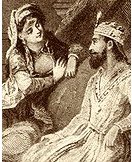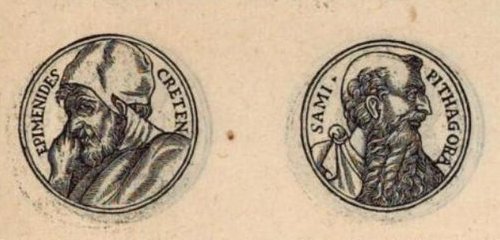|
584
27 By the way, sacred numbers were always meaningful: ... About Carmenta we know from the historian Dionysus Periergetis that she gave orcales to Hercules and lived to the age of 110 years. 110 was a canonical number, the ideal age which every Egyptian wished to reach and the age at which, for example, the patriarch Joseph died. The 110 years were made up of twenty-two Etruscan lustra of five years each; and 110 years composed the 'cycle' taken over from the Etruscans by the Romans. At the end of each cycle they corrected irregularities in the solar calendar by intercalation and held Secular Games. The secret sense of 22 - sacred numbers were never chosen haphazardly - is that it is the measure of the circumference of the circle when the diameter is 7. This proportion, now known as pi, is no longer a religious secret; and is used today only as a rule-of-thumb formula, the real mathematical value of pi being a decimal figure which nobody has yet been able work out because it goes on without ever ending, as 22 / 7 does, in a neat recurring sequence [3.142857142857 ...]. Seven lustra add up to thirty-five years, and thirty-five at Rome was the age at which a man was held to reach his prime and might be elected Consul ... Therefore we should here look again, with fresh eyes, at number 1212:
A first idea might be to count 12 * 12 = 144, a square measuring 12 by 12. → (= by consequence of which) we could come to reflect on the sacred idea of 365 = 10 * 10 + 11 * 11 + 12 * 12 = 100 + 121 (the first 3 numbers in 1212) + 144. The number of the cycle of the Sun year was sacred not only because it was a fact known since the very beginning of reflective thinking:
I am reflecting, therefore I am. But also because this number confirmed the observed fact (axiom) - which I myself once upon a time had (re)discovered from reflecting upon the Pythagorean basic number triangle: 3 * 3 + 4 * 4 = 5 + 5 Only these 3 consecutive numbers could fulfil the beautiful equation for the basic right angled Pythagorean triangle: n * n + (n+1) * (n+1) = (n+2) * (n+2) Spurred on by this amazing fact I tried to expand the idea into: n * n + (n+1) * (n+1) + (n+2) * (n+2) = (n+3) * (n+3) + (n+4) * (n+4) And sure enough, there was also here only one set of integers which fulfilled my new equation: 10 * 10 + 11 * 11 + 12 * 12 = 13 * 13 + 14 * 14 100 + 121 (→ Beltaine) + 144 = 169 + 196 = 365 Therefore 121 * 2 should be meaningful. And indeed 121 * 2 = 242 = 365 - 123. One engenders two (one more), two engenders three (one more), and three engenders everything. ... Next step surely should be to add 61 days to 181 in order to reach 242, because the day distance from August 14 (226) to October 14 (287) is 61 (→ 366 / 6) days. The precession could evidently have moved the stars ahead with 2 months in the Sun calendar ...
Another reflection (→ Hugin) is to remember (→ Munin, the other Raven bird resting on the shoulders of Odin) that 212 was the number for the sum of glyphs on the D tablet.
1001, One Thousand and One Night, is expressing the remarkable (con)sequence of integers. It never ends, there will always be one more. 1212 can then be another expression of the same idea: 1000 plus one more cycle of 212. As a kind of confirmation of the validity of this kind of reflective reasoning - never ending but always creating a new idea - we can count once more:
1212 = 584 + 628 (= 2 * 314). And 628 (E) + 212 (D) = 840 (→ 60 fortnights = 30 * 28 = 420 * 2 = 210 * 4). 628 / 4 = 157 and 157 + 53 = 210 (→ 7 * 30 → 420 / 2 = 6 * 70 / 2 = 6 * 35). ... Epimenides lived to be one hundred and fifty-seven years ...
As to number 53 it could reasonably be referring to February 22 (53 = 31 + 22), because 22 signified π, and because then came TERMINALIA:
|
||||||||||||||||||||||||||||||||||||||||||||||||||||||||||||||||||||||||||||||||||||||||||






